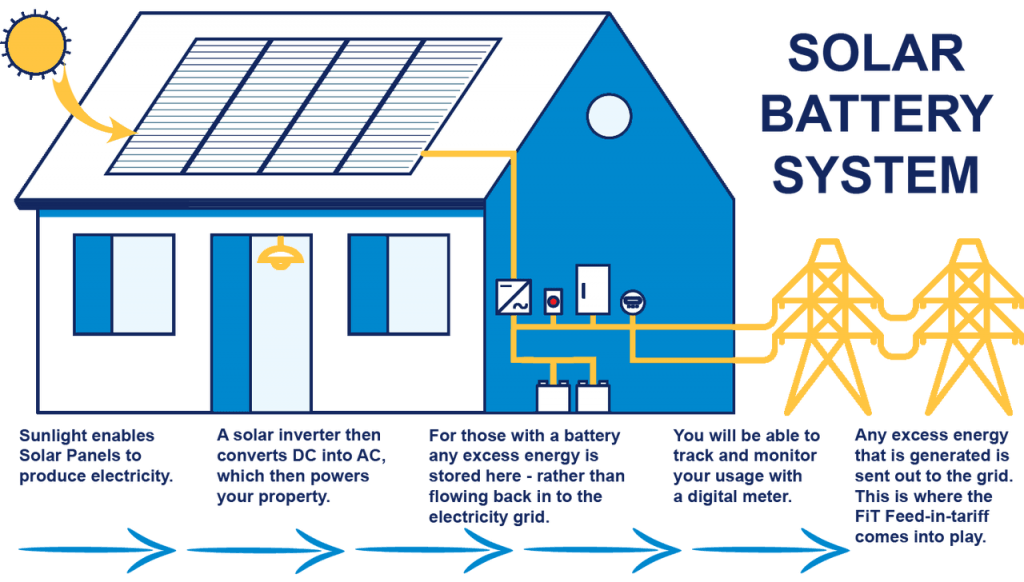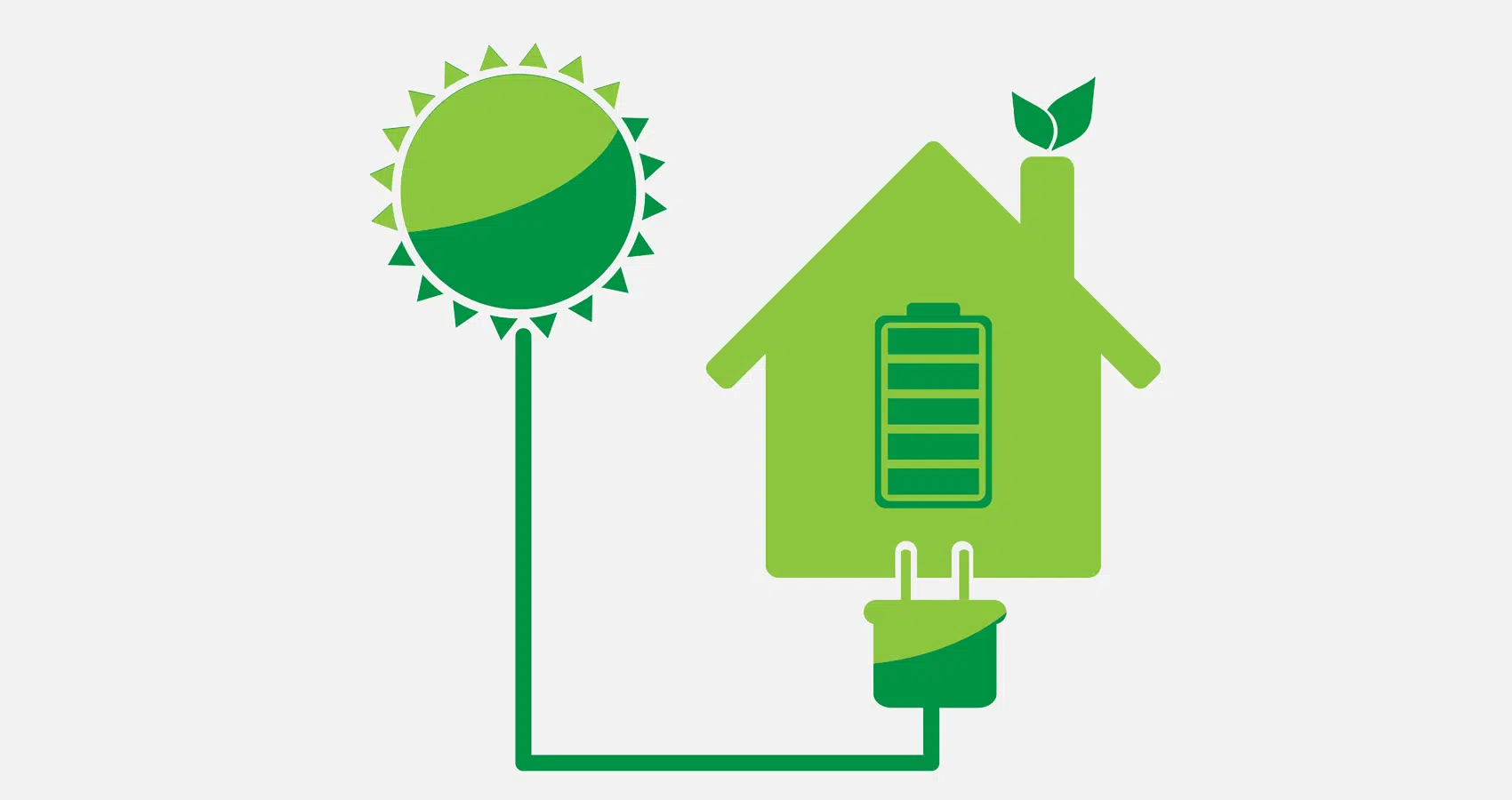Обзор
В связи с растущим глобальным спросом на чистую энергию, солнечная энергия как возобновляемый источник энергии получает все большее внимание и применение. Однако, из-за нестабильности и непостоянства солнечной энергии, как эффективно хранить и использовать солнечную энергию стало одной из важных задач настоящего и будущего.. В результате появились системы хранения солнечной энергии., не только балансировать спрос и предложение энергии, но и обеспечение устойчивого электроснабжения, продвижение более широкого применения на рынке возобновляемых источников энергии.

Основные концепции систем хранения солнечной энергии
Основной принцип системы хранения солнечной энергии заключается в преобразовании и хранении электрической энергии, захваченной солнечными панелями, для будущего использования..

Эти системы обычно состоят из основных компонентов, таких как солнечные панели., аккумуляторные блоки, инверторы, и системы мониторинга. Солнечные панели используют фотоэлектрический эффект для преобразования солнечной энергии в постоянный ток., в то время как аккумуляторные батареи используются для хранения этой энергии, а инверторы отвечают за преобразование постоянного тока в переменный для бытового или коммерческого использования..
В системе хранения солнечной энергии, неиспользованная солнечная энергия в течение дня сохраняется в батареях, а затем используется ночью для дополнения или замены электрической энергии, обеспечиваемой сетью..
Принцип работы системы солнечной батареи - ключевой часть системы хранения солнечной энергии

Солнечные панели являются одним из ключевых компонентов солнечных систем.. Они состоят из нескольких фотоэлектрических элементов., которые преобразуют солнечный свет в электричество с помощью полупроводниковых материалов (В настоящее время на рынке популярен монокристаллический кремний.). Когда фотоны попадают на поверхность панели аккумулятора, они возбуждают электроны, производство электрического тока. Вот более конкретное введение: Введение в структуру литий-ионного аккумулятора 2024
Эти токи подаются на аккумуляторную батарею через электрические соединения или напрямую подаются для использования.. В последние годы, эффективность преобразования солнечных панелей постоянно улучшается, производственные затраты постоянно сокращаются, и технологические инновации укрепили их конкурентоспособность на рынке..
Как работает система солнечных батарей?
Принцип работы систем хранения энергии на солнечных батареях очень похож на традиционные системы хранения энергии.. Фотоэлектрический (PV) панели улавливают солнечный свет и преобразуют его в постоянный ток (ОКРУГ КОЛУМБИЯ) электрическая энергия. Этот вид электрической энергии подается потребителям через инвертор.. Инвертор – это устройство, преобразующее постоянный ток в переменный. (переменный ток) используется конечными пользователями.
В этот момент, произведенная электроэнергия будет немедленно потребляться или продаваться в общественную сеть, если она не нужна конечному пользователю.. Если добавлены батарейки, можно проводить работы по накоплению энергии для накопления электроэнергии для будущего использования, например, ночью или в периоды пиковых цен на электроэнергию.

Если вы хотите знать, как добавить систему аккумуляторных устройств в солнечную систему, ответ прост: свяжитесь с нами по GycxSolar сейчас. Мы разрабатываем для вас эксклюзивные решения, понимая ваши потребности в потреблении электроэнергии., установка солнечных панелей и мест размещения аккумуляторов, и предоставление комплексных услуг.
Как долго солнечная энергия может храниться в батареях?
Вообще говоря, Запаса энергии солнечных элементов может длиться от одного до пяти дней. Некоторые производители аккумуляторов также утверждают, что их аккумуляторы можно использовать непрерывно до семи дней.. Как время автономной работы, на емкость аккумулятора влияет множество факторов, включая среду использования, оригинальная емкость аккумулятора, количество полных циклов заряд-разряд, температура окружающей среды, и работы по обслуживанию аккумуляторов.
Сколько энергии могут хранить солнечные батареи?

Независимо от условий установки и здоровья, влияние времени использования на емкость аккумулятора, Солнечные аккумуляторные батареи GycxSolar имеют широкий спектр характеристик.. С точки зрения функциональности, Самая маленькая система хранения солнечной энергии может обеспечить потребление электроэнергии обычными домохозяйствами примерно на четыре часа.. Батарея большего размера имеет большую емкость и обеспечивает более длительное время использования энергии..
Каждая технология аккумуляторов имеет свои особенности., и по продолжительности жизни, Большинство батарей, подключенных к фотоэлектрическим системам, в настоящее время являются «батареями глубокого цикла», и материал в основном литий-ионные аккумуляторы. Это обеспечивает им очень длительный срок службы и чрезвычайно большое количество циклов.. В районах с мягким климатом (или наиболее подходящая среда для работы от аккумулятора), аккумулятор имеет более длительный срок службы и лучшее сохранение производительности.
В системе хранения солнечной энергии, система солнечных батарей является основным компонентом, и понимание того, как это работает, очень полезно для понимания того, как работает ваша система хранения солнечной энергии..
Сколько стоит система хранения солнечных батарей?
Фактическая разница в стоимости инвестиций в фотоэлектрические системы связана с выбором типа батарей., и цена солнечных батарей может варьироваться в зависимости от разных категорий, таких как емкость батареи.. Однако, со зрелостью рынка и постоянным развитием технологических исследований, снижение затрат на производство аккумуляторов также постепенно сделало их более доступными..
Когда общая стоимость превышает стоимость традиционных систем, люди могут колебаться при принятии решений об инвестициях в стоимость энергии. Важно понимать, что это долгосрочный проект.. Вообще говоря, при выборе таких систем, как сетевое подключение, избыток электроэнергии может быть передан обратно для максимизации экономической отдачи., что может привести к снижению долгосрочных затрат на амортизацию.
Согласование других компонентов устройства в системе хранения солнечной энергии
Аккумуляторная батарея — это основное устройство хранения энергии в системе хранения солнечной энергии., состоит из батареек, в основном используется для хранения электроэнергии, вырабатываемой солнечными панелями. Рассмотрите возможность выбора типов аккумуляторных блоков, соответствующих требованиям и бюджету системы, чтобы обеспечить стабильную работу и долгосрочную надежность..
Инверторы также играют решающую роль в системах хранения солнечной энергии., поскольку они отвечают за преобразование постоянного тока в переменный для использования пользователями..

Системы хранения солнечной энергии обычно требуют интеллектуальных систем мониторинга, которые облегчают мониторинг эффективности солнечных панелей в режиме реального времени., состояние зарядки и разрядки аккумуляторных блоков, и энергопотребление. Через анализ данных и оптимизацию, пользователи могут своевременно корректировать свои стратегии использования энергии, повысить энергоэффективность, продлить срок службы оборудования, и тем самым снизить затраты на электроэнергию. Система хранения солнечной энергии помогает пользователям снизить зависимость от традиционных невозобновляемых источников энергии..
Основные преимущества и сроки использования системы хранения солнечной энергии
- Избежание воздействия роста цен на электроэнергию и использование автономных систем равносильно тому, что вам больше никогда не придется платить государству по счетам за электроэнергию.
- 100% солнечная энергия для собственного использования, достижение высокой доходности
- Уменьшите или устраните свой углеродный след
- Обеспечьте бесперебойное электроснабжение вашей семьи.
Хранение энергии на солнечных батареях — это надежная технология, которая может помочь пользователям сократить расходы на электроэнергию, когда это необходимо., обеспечить энергообеспечение в случае отключения электроэнергии, и повысить свою энергетическую независимость. Более того, солнечный элемент работы по хранению энергии на основе возобновляемых источников энергии, который также помогает снизить выбросы парниковых газов и является очень чистым и высококачественным экологически чистым устройством хранения энергии..
Люди верят, что одна из слабостей солнечной энергии заключается в том, что когда солнце не светит, нет электричества. Хотя, возможно, так было и в прошлом, это уже не относится к системам хранения энергии.

Одним из примеров системы хранения солнечной энергии является отключение электроэнергии, вызванное экстремальными погодными условиями или проблемами с обслуживанием общественной сети.. Когда электросеть теряет мощность, аккумуляторная система запускается и автоматически и плавно берет на себя электропитание, не прерывая электроснабжение конечных пользователей. Это не единственное преимущество этой системы..
Фактически, Системы хранения солнечной энергии в сочетании с солнечными панелями имеют множество преимуществ с точки зрения экологической устойчивости., экономика, и гибкость в обеспечении энергией, включая, но не ограничиваясь: сочетание солнечной энергии и систем хранения аккумуляторов также может помочь снизить счета потребителей за электроэнергию., обеспечить снижение их зависимости от электроэнергии из общественной сети, и получать доход за счет эффективного использования энергии и покупки избыточной электроэнергии.
Система хранения солнечной энергии предоставляет жителям и бизнес-пользователям четкие методы сокращения выбросов углекислого газа., сокращение выбросов углекислого газа в атмосферу.
Заключение
В итоге, Я думаю, вы поняли, как работают системы хранения солнечной энергии.: они эффективно захватывают, конвертировать, и хранить солнечную энергию, компенсировать нестабильность производства солнечной энергии, и предоставим качественные услуги для вашей жизни.
Понятно, что система хранения солнечной энергии широко используется в жилых и коммерческих помещениях., а также играет важную роль в системах сельского электроснабжения и аварийного резервного электроснабжения..

В условиях растущего глобального спроса на чистую энергию и технологические достижения, Перспективы рынка систем хранения солнечной энергии обширны. С развитием технологий и расширением рынка, система хранения солнечной энергии занимает более важное место в мировой энергетической структуре, играя все более важную роль в содействии преобразованию чистой энергии и внося все больший и больший вклад в устойчивое развитие. Поэтому, мы должны признать, что система хранения солнечной энергии сделает жизнь лучше.
